Eamon de Valera once said: “whenever I wanted to know what the Irish people wanted I had only to examine my own heart and it told me straight off what the Irish people wanted.” Nowadays he would have opinion polls at his disposal, although they also come with a margin for error.
Ireland was relatively late in having regular political polling. The first in depth poll was by Gallup on behalf of the Labour Party in April 1969. It was subsequently published in Nusight magazine edited by Vincent Browne. Their editorial suggested that “Ireland must be one of the least polled countries in Europe”. However, it was another decade before they appearing regularly in newspapers – much later than United States (since 1930s) and United Kingdom (since 1940s).
The novelty they once had was evident when the Fine Gael – Labour Government commissioned the Market Research Bureau of Ireland (now Ipsos MRBI) to carry out a pre-election poll in 1977. Public and private polls were around but were not yet an established part of politics. Nor indeed did they have a track record. Jack Jones (founder of MRBI) recalled that when presenting Ministers and advisers with statistics (correctly) predicting a Fianna Fail landslide, many in the room did not appear to understand the findings. Conor Cruise O’Brien (who would lose his seat) dismissed them as they “did not tally with the messages he was getting on the doorsteps in Howth”. In his autobiography, Garret Fitzgerald claimed Taoiseach Liam Cosgrave was particularly dismissive of polls, preferring to be “guided on public opinion by individual letters he received from time to time, extracts of which he sometimes read to use in Government”.
After their success in predicting the 1977 vote, polling finally became regular feature. The two main series were Irish Marketing Surveys (now part of Kantar Milward Brown) for Irish Times and MRBI for the Irish Independent. The two companies then switched paper in 1982. Below are graphs from the Irish Times series (mainly because data was easier to find!). The sources are:
- Jack Jones “In your opinion: political and social trends in Ireland through the eyes of the electorate” (2001): Appendix includes headline Irish Times – MRBI polling from 1982-2001
- Irish Times Archive – Usually a new poll includes an article by a company director (Jack Jones, Ian McShane, Damian Loscher) containing a time-series of headline questions.
- Irish Times Website – Ipsos MRBI data going back to 2006.
- Irish Political Studies – In 1980s and early 1990s its annual Data Section included detailed information on Irish Times – MRBI polling.
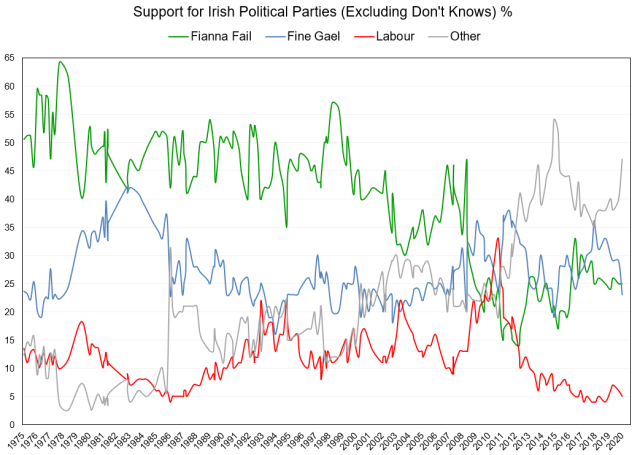
Source for All Graphs: Irish Times – IMS / Ipsos MRBI
Historic Irish polling has four consistent parts: the 3 established parties – Fianna Fail, Fine Gael and Labour Party – and an “Other” remainder. The usual margin of error applies throughout and would explain much of the short-term volatility. As mentioned, polling from 1975 to June 1982 is IMS and from October 1982 to January 2020 is Ipsos MRBI. The first published Irish Times IMS poll was actually in August 1978. Fortunately articles on the poll included a time series of polling that was unpublished or commissioned by RTE. A note of caution with IMS is that before 1977 election some respondents responded “Coalition (Unspecified)”. So, it’s reasonable to assume that Fine Gael and Labour support is slightly deflated and “Other” inflated. An alternative would be the sacrifice three years and start in October 1977.
The former dominance of Fianna Fail is the graph’s most striking feature. Their support peaked at 64% in October 1977 – following an election win thanks to an infamous giveaway manifesto. For the next 30 years support fluctuated between 40-55%. An uptick occurred in 1998 after the Good Friday Agreement and during the Celtic Tiger. A notable sharp fall (and perhaps a harbinger of things to come) was 34% in November 1994. This was after the fall of government in addition to the ongoing fallout from the Beef Tribunal and Brendan Smyth case. Fallibility to FF’s once solid support was also evident in early 2000s. An accumulation of corruption findings at Tribunals and a weakening economy were partly to blame. Then the economic crisis of 2008 caused a spectacular collapse. FF support fell from 47% in May 2008, to 23% in May 2009, and to 15% in February 2011. The party has since recovered slightly in polls and election but have been knocked of their perch.
Fine Gael’s performance has been more mixed. Their peak was 42% in 1982/83. They did not return near that level until post-financial crisis, with high 30s in summer of 2009 and run up to the February 2011 election. The first time FG were ever ahead of FF was in November 2008. (They were level in October 1982). In terms of public opinion this was perhaps the first time ever. Or first time since 1920/30s if you count Cumann na nGaedheal.
Yet even with FF plummeting their support was not secure. For instance, it fell to mid-20s in summer 2010, prompting Richard Bruton’s failed heave against Enda Kenny. In government FG’s popularity has waned, although to a level not unique in their polling or electoral history. The lowest recorded was 16% in January 1994 and it was below 20% on several occasions in pre-crash 2000s.
Labour is even more mixed. There were several significant rises in support – most famous being “Spring Tide” of early 1990s and “Gilmore Gale” of 2010, as well as two (thankfully) unnamed increases in 1979 and early 2000s. Two 2010 polls – June (29%) and September (33%) – saw the party as the most supported. The first time for them and any third party. As with previous experiences in office, Labour’s popularity has suffered, although it appears recovery has been slower than usual. The public now have more choice.
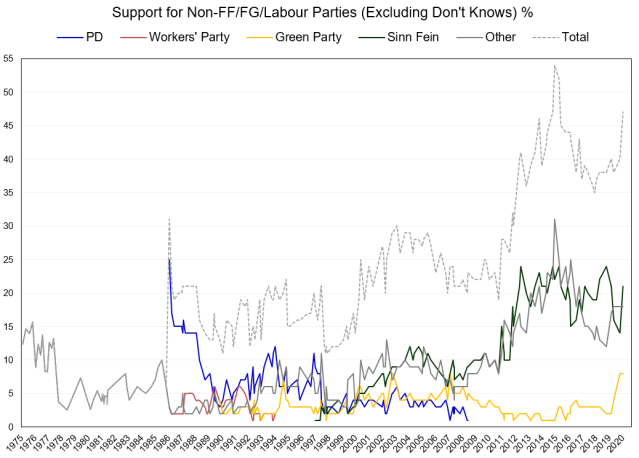
Accompanying the fall of FF has been the rise of other parties and independents. Challenges to FF/FG/Labour are not new. In the 1940s there was Clann na Poblachta and Clann na Talmhan. In February 1986 the Progressive Democrats polled 25% – the first since their founding and above FG. The Workers’ Party polled 6% several times in late 1980s and threatened to make breakthroughs in urban areas. The emergence of Sinn Fein in the 2000s pushed “Others” up to 30%. But everything has changed since the financial crisis.
SF’s are now a major party. For nearly a decade they have polled in-and-around 20%, although they have under-performed in elections (with exception of Europeans 2014). In October 2014 they were narrowly the largest party – something they have achieved in other polls several times.
The Green Party’s support has not always been sustainable. The 3 “Green Waves” were: after the 1994 European elections, before the 2007 General Election, and post-European/Locals in 2019. The recent upswing is very much a reversal in fortune. In a few 2014/15 polls they were in fact below Ipsos MRBI’s 1% threshold and lumped in the “Other/Independent” category.
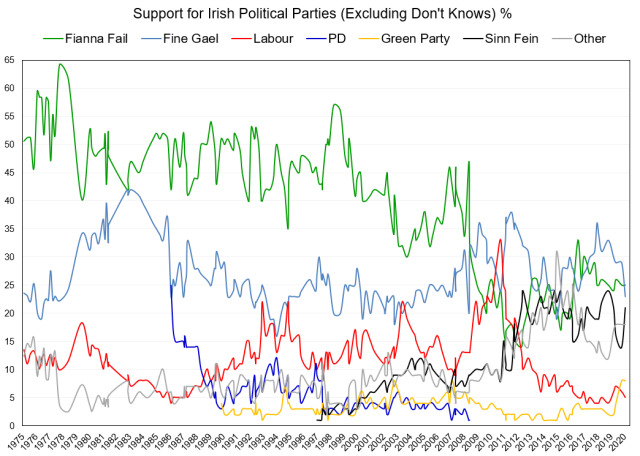

The major “Other” parties – say those who won over 10% in an election – could be added. Throwing more in does make the graph look [even more] unreadable. But perhaps it’s just an accurate illustration of modern Irish politics. It does show fragmentation since the economic crisis. This may well have happened anyway given trends in other countries. Perhaps it just accelerated the process. Table of decadal averages again highlights the main trends: FF down, FG/Labour up-and-down, PDs gone, SF up, and Green Party down but up again at time of writing.
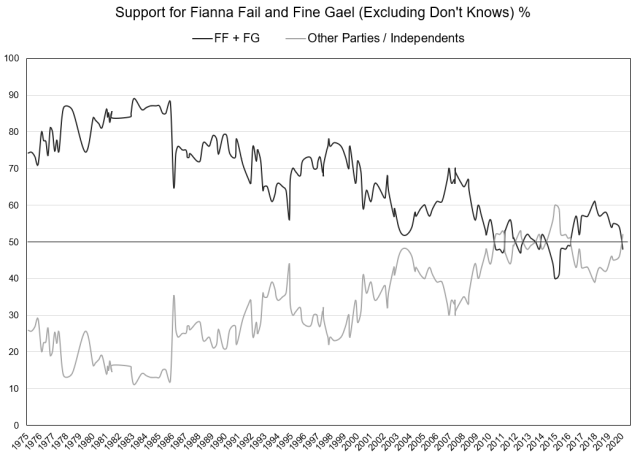
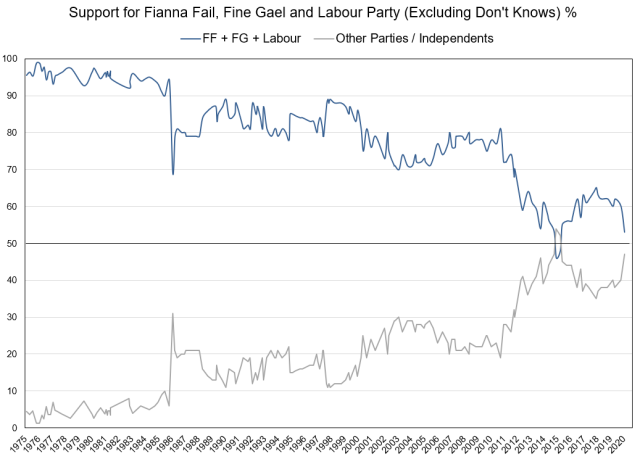
In the days of Haughey versus Fitzgerald, FF and FG held nearly 90% of the public. In recent years it has fallen below 50%. The second graph shows the combined FF, FG and Labour vote. (Here the problematic “Coalition” option of the 1970s is added). Previosuly Labour had been the primary cause of FF plus FG dips. But no longer. Now even the three legacy parties have fallen below 50% at times.
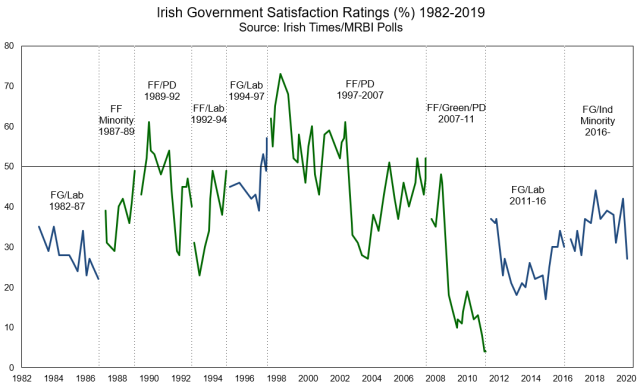
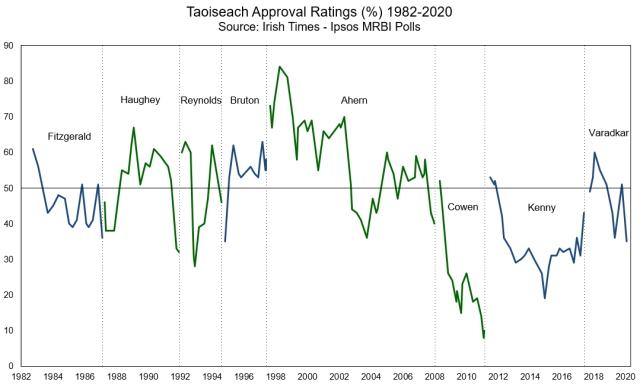
The other headline questions are on party leader and government satisfaction. There is obviously a correlation between the two. Although typically approval for Taoiseach is above both government and party support. The highest support for government (73%) and Taoiseach (84%) were both in April 1998 (just after the Good Friday Agreement). At the height of the Celtic Tiger and Peace Process in Northern Ireland, approval ratings were regularly above 50%. The lowest for government (4%) and Taoiseach (8%) were both in February 2011. Since the crisis approval has clearly fallen. The last time most Irish people were satisfied in their government was May 2007 – nearly 13 years ago.
